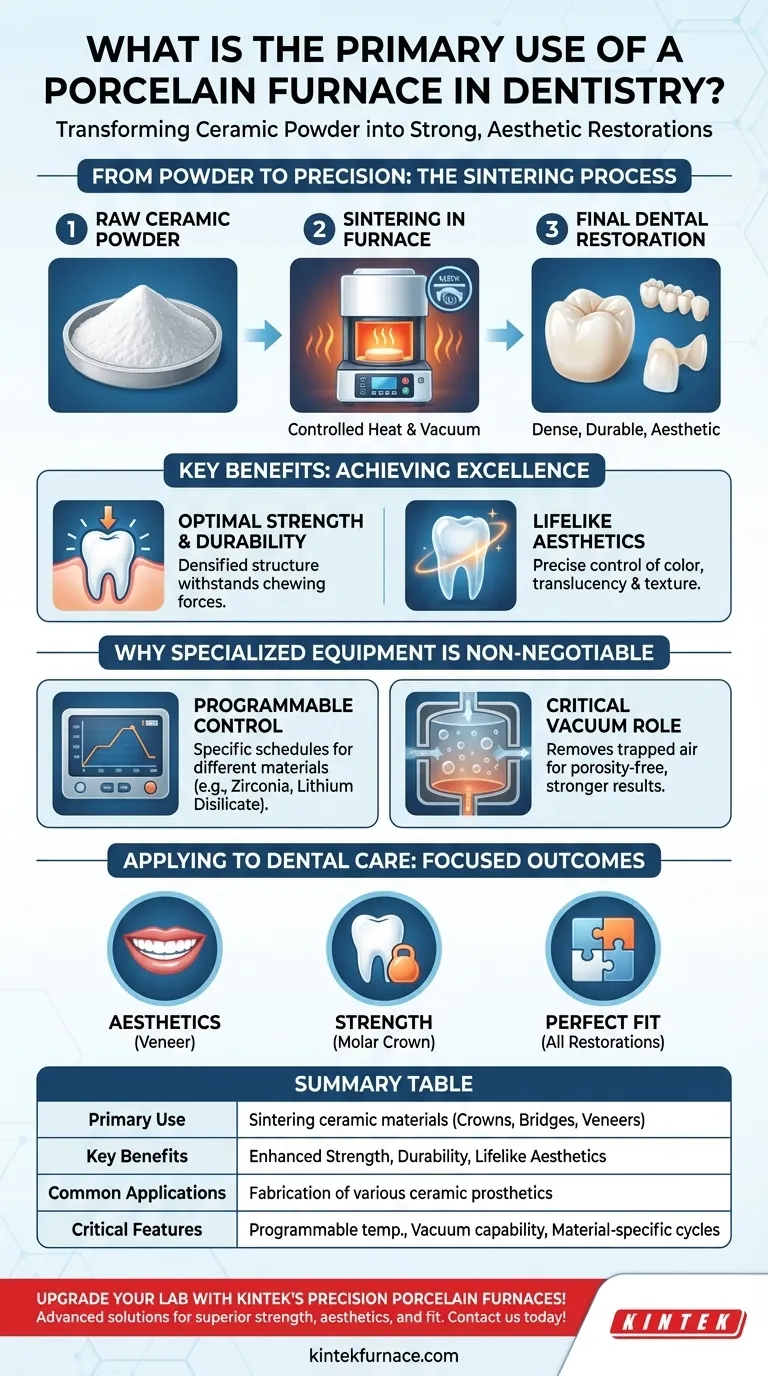In simple terms, a porcelain furnace is a specialized, high-temperature oven used in dental laboratories to fire, or "sinter," ceramic materials. This process transforms raw dental porcelain into the strong, durable, and aesthetically pleasing crowns, bridges, veneers, and other restorations that are ultimately placed in a patient's mouth.
The true purpose of a porcelain furnace is not merely to heat material, but to precisely control a complex transformation. It turns a fragile ceramic powder into a dense, non-porous restoration with the exact strength, color, and translucency required to mimic a natural tooth.
From Powder to Precision: The Sintering Process
A porcelain furnace is the critical tool that enables the fabrication of high-quality dental ceramics. Its function goes far beyond simple heating, involving a highly controlled process known as sintering.
What is Sintering?
Sintering is the process of compacting and forming a solid mass of material by heat and pressure without melting it to the point of liquefaction.
In dentistry, ceramic particles are fused together, reducing the space between them and creating a dense, unified structure. This is what gives the final restoration its strength.
Achieving Optimal Strength and Durability
The primary goal of firing a restoration is to achieve a specific level of maturity and density.
A properly executed sintering cycle ensures the ceramic reaches its maximum potential strength, allowing it to withstand the significant chewing forces it will encounter in the mouth.
Crafting Lifelike Aesthetics
The furnace's precise control over the firing cycle is directly responsible for the final appearance of the restoration.
Factors like translucency, surface texture, and color (hue and chroma) are all developed during these carefully managed heating and cooling phases. Without this control, a crown would look opaque and artificial.
Why a Specialized Furnace is Non-Negotiable
You cannot substitute a conventional oven for a dental porcelain furnace. The unique requirements of dental ceramics demand a level of precision that only specialized equipment can provide.
The Need for Programmable Control
Different types of dental ceramics, such as zirconia or lithium disilicate, require unique firing schedules.
Modern porcelain furnaces allow technicians to program specific temperatures, heating rates, and hold times. This ensures each material is processed according to manufacturer specifications for predictable, high-quality results.
The Critical Role of Vacuum
Many firing cycles are performed under a vacuum. This pulls air out of the ceramic material before the particles fuse together.
Removing this trapped air eliminates porosity, which is a major source of weakness and opacity in the final restoration. A vacuum ensures a denser, stronger, and more translucent result.
Common Pitfalls and Considerations
While essential, a porcelain furnace is a precision instrument that comes with its own set of operational requirements and limitations.
Material-Specific Protocols
A furnace is not a "one size fits all" device. Using a firing program designed for one type of ceramic on another will lead to a failed restoration. This can result in poor fit, incorrect color, or catastrophic fracture.
The Importance of Calibration
To maintain accuracy, porcelain furnaces require regular calibration. An uncalibrated furnace that runs too hot or too cool will consistently produce weak, ill-fitting, or aesthetically poor restorations, wasting time and expensive materials.
The Barrier of High Initial Cost
These are highly specialized and expensive pieces of equipment. The cost represents a significant investment for a dental laboratory, but it is an essential one for producing modern, high-quality ceramic work.
Applying This to Your Dental Care
Understanding the role of the furnace helps clarify what makes a high-quality dental restoration possible. The final result is a direct product of the materials and the precision of the fabrication process.
- If your primary focus is aesthetics (e.g., a front veneer): The furnace's ability to create natural translucency and perfect color matching is what makes the restoration indistinguishable from a real tooth.
- If your primary focus is strength (e.g., a molar crown): The furnace's power to achieve full, dense sintering is what provides the long-term durability needed to withstand heavy chewing.
- If your primary focus is a perfect fit (for any restoration): The furnace's precise, repeatable process minimizes shrinkage and distortion, ensuring the final product seats perfectly on the prepared tooth.
Ultimately, the porcelain furnace acts as the bridge between raw ceramic material and a functional, lifelike dental restoration.
Summary Table:
| Aspect | Details |
|---|---|
| Primary Use | Sintering ceramic materials for dental restorations like crowns, bridges, and veneers |
| Key Benefits | Enhanced strength, durability, and lifelike aesthetics through controlled heating and vacuum processes |
| Common Applications | Fabrication of crowns, bridges, veneers, and other ceramic dental prosthetics |
| Critical Features | Programmable temperature control, vacuum capability, and material-specific firing cycles |
Upgrade your dental lab with KINTEK's precision porcelain furnaces! Leveraging exceptional R&D and in-house manufacturing, we provide advanced high-temperature solutions tailored for dental laboratories. Our product line, including Muffle, Tube, Rotary Furnaces, Vacuum & Atmosphere Furnaces, and CVD/PECVD Systems, is complemented by strong deep customization capabilities to meet your unique experimental needs. Achieve superior strength, aesthetics, and fit in your restorations—contact us today to discuss how we can enhance your workflow and results!
Visual Guide

Related Products
- Dental Porcelain Zirconia Sintering Ceramic Vacuum Press Furnace
- Chairside Dental Porcelain Zirconia Sintering Furnace with Transformer for Ceramic Restorations
- 1700℃ High Temperature Laboratory Tube Furnace with Quartz or Alumina Tube
- High Temperature Muffle Oven Furnace for Laboratory Debinding and Pre Sintering
- Vacuum Sealed Continuous Working Rotary Tube Furnace Rotating Tube Furnace
People Also Ask
- What is the purpose of dental sintering furnaces? Transform Zirconia into Durable, High-Quality Dental Restorations
- Why is precise temperature control important in dental sintering furnaces? Ensure Strong, Aesthetic Dental Restorations
- What factors determine the quality of sintered zirconia restorations? Master Material, Equipment, and Technique
- Why is proper ventilation important in dental sintering furnaces? Ensure Quality and Safety in Your Lab
- What is a dental sintering furnace and what is its purpose? Achieve High-Strength Dental Restorations



















